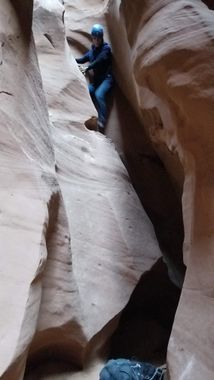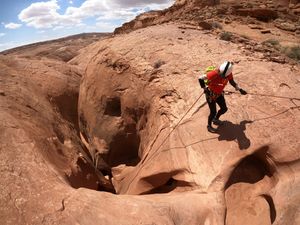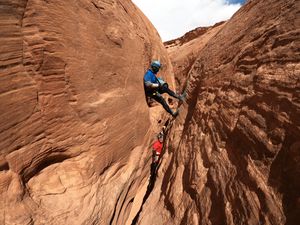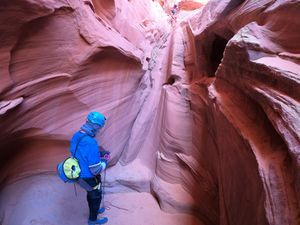Leprechaun Canyon (West Fork)
| Rating: | |||||||||||||||||||||||||||||||
|---|---|---|---|---|---|---|---|---|---|---|---|---|---|---|---|---|---|---|---|---|---|---|---|---|---|---|---|---|---|---|---|
| | Difficulty:3A II (v3a1 II) Raps:0 - 4, max ↨45ft
Red Tape:Permit required Shuttle:None Vehicle:Passenger Rock type:Sandstone | ||||||||||||||||||||||||||||||
| Location: | |||||||||||||||||||||||||||||||
| Condition Reports: | 15 May 2025
"Anchors were all good with very nice courtesy anchor setups on most of the more mandatory rappels to reduce rope grooves. Some webbing is probably ge |
||||||||||||||||||||||||||||||
| Best season: | Spring or Fall
|
||||||||||||||||||||||||||||||
| Regions: | |||||||||||||||||||||||||||||||
Introduction[edit]
Approach[edit]
Leprechaun Canyon can be explored using two primary approaches: a bottom-up hike starting near Highway 95 or a top-down route beginning at the upper trailhead accessible via the Turkey Knob dirt road.
Top-Down Approach[edit]
The upper trailhead is located along Turkey Knob Road, a dirt road passable to most vehicles, although high-clearance is recommended. This road is marked on most maps, so detailed directions are not included here. Pro Tip: Parking can become crowded. Turn your vehicle around when parking to avoid maneuvering difficulties later.
From the trailhead, several social trails lead southward following natural watercourses but two routes are most prominent. To minimize environmental impact, stick to these established routes, which should appear on most modern maps.
Western Approach Drainage: This is best for reaching the West or Middle Leprechaun Forks.
- Take the western route which initially heads toward what will become the Middle Leprechaun drainage but intersects a well-defined social trail before reaching it.
- At the trail intersection head west (heading east would lead to the East Fork of Leprechaun Canyon)
- As you travel west the trail curves towards the southwest and crosses a minor drainage.
- Continue onward until encountering the next, more significant drainage. This marks the entrance to West Leprechaun Canyon.
(Alternative) Eastern Approach Drainage: This is most suitable for accessing the East Leprechaun Fork, and while it will get you to the other forks, it is a less efficient option for doing so.
Bottom-Up Approach[edit]
Near Highway 95, a short dirt road next to the Leprechaun Canyon drainage provides an ideal parking area for your starting/exit vehicle. From this point:
- Begin hiking up the main wash.
- Look out for a notable side canyon joining from the west (left side, up-canyon).
- At this juncture, leave the drainage and ascend the slickrock nose that lies between the main wash and the side canyon. Avoid entering the side canyon, as it dead-ends.
- Climb the slickrock ridge, which naturally divides the two drainages. While cairns may mark the route, continue ascending to stay on track. As you approach the top, before reaching the mesa, the terrain flattens and transitions to dirt. Shift leftward toward the top of the side drainage.
- A well-defined social trail begins here and should be easy to follow. The trail will lead you into a small draw and then up onto the mesa top, offering stunning views of Leprechaun Canyon and its forks to the east.
- Continue along the trail as it traces the canyon rim. (Note: This trail will guide you to all forks of Leprechaun Canyon or the upper trailhead.)
- To access the West Fork of Leprechaun Canyon, leave the trail when it crosses the first significant drainage.
West Leprechaun Drainage[edit]
Regardless of which approach route is taken, once the drainage for West Leprechaun Canyon is reached, leave the social trail and head down the drainage. From here you will have two options for starting the canyon which are detailed below.
Descent[edit]
The top of the West Fork of Leprechaun Canyon also has two small forks, or prongs. Historically canyoneers would begin the canyon by winding their way around the rim of the east prong down to a spot in the main drainage where both prongs meet. Today, however, it is more common to directly descend the canyon via the west prong but both options are described here.
Standard (West Prong) Start[edit]
Once in the West Leprechaun drainage, simply rappel the first drop you encounter. There will likely be a very overbuilt cairn anchor here making it pretty obvious that this is where to start.
- R1: 30 feet - Anchored via a cairn.
- R2: 25 feet - Anchored via a cairn.
Traditional (Bypass) Start[edit]
Once in the West Leprechaun drainage, instead of rappelling at the first drop, contour to the east following a shelf below the top of the mesa. Continue to a rocky finger that points southward and gives way to the slickrock rim east of the east prong. From here walk down the slick rock bowl to the junction between the two prongs. At this junction will be rappel 3 (or what was traditionally the first rappel.
Main Canyon[edit]
- R3: 35 feet - Anchored via a deadman in a small pothole.
- R4: 30 feet - Anchored from a large rock about 10 feet back from the drop.
- R5: 25 feet - Anchored from a deadman.
Exit[edit]
Once through the narrow section the canyon opens up to a stunning corridor with sheer walls arching up on both sides. Take a moment to enjoy this spot and gear down then continue down canyon as the cliff walls recede and the canyon opens up into a draw. Follow the main sandy wash back to the highway.
Red tape[edit]
Permits[edit]
Due to a high volume of search and rescue incidents, the Garfield County Sheriff's Office now requires all individuals to obtain a FREE PERMIT before entering this canyon. Entering without a valid permit may result in a Class B misdemeanor.
For more information and to obtain your permit, visit: https://www.brycecanyoncountry.com/permits/
Beta sites[edit]
 BluuGnome.com : Leprechaun Canyon - Left (west) Fork
BluuGnome.com : Leprechaun Canyon - Left (west) Fork Chris Brennen's Adventure Hikes (Southwest) : Leprechaun Canyon
Chris Brennen's Adventure Hikes (Southwest) : Leprechaun Canyon RoadTripRyan.com : Leprechaun Canyon
RoadTripRyan.com : Leprechaun Canyon Climb-Utah.com : Leprechaun Canyon- North Wash
Climb-Utah.com : Leprechaun Canyon- North Wash HikeArizona.com : Leprechaun Canyon
HikeArizona.com : Leprechaun Canyon CanyonCollective.com : Leprechaun West Fork
CanyonCollective.com : Leprechaun West Fork Super Amazing Map : West Leprechaun
Super Amazing Map : West Leprechaun CanyoneeringUSA.com : Leprechauns-3 Technical Forks
CanyoneeringUSA.com : Leprechauns-3 Technical Forks
Trip reports and media[edit]
 Candition.com : Leprechaun Canyon; North Wash
Candition.com : Leprechaun Canyon; North Wash




